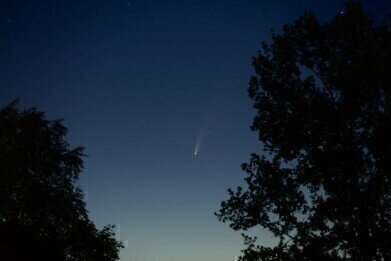News
Asteroid 2004 BL86 Flew Past Earth. And It Has Its Own Moon!
Feb 03 2015
Scientists, who have been tracking the asteroid known as 2004 BL86, have discovered that it has its own moon. The asteroid, which measures 325 meters wide, passed the Earth on January 26, at a distance of 1.2 million kilometres. That’s three times the distance from Earth to the Moon.
The encounter was the closest that this asteroid will come to Earth and it gave researchers a chance to spot the small satellite moon, using radar imaging. Thankfully, the asteroid missed earth, but we did hypothesise in this news story what would happen if 2004 BL86 did hit us.
Thanks to this radar technology, researchers could measure the small moon at 70 meters wide. Radar measurements are also useful for calculating the shape, rotation, surface features and the roughness of asteroids. They are also used when determining the orbits of asteroids.
The asteroid 2004 BL86 was discovered in 2004 in New Mexico by the Lincoln Near-Earth Asteroid Research (LINEAR) in White Sands. The research centre is a collaboration between the United Air Force, NASA and Massachusetts Institute of technology’s Lincoln Laboratory. It specialises in detecting and tracking near-Earth asteroids.
Although the encounter on Monday was the closest the asteroid would ever get to the Earth, thanks to the work from LINEAR, researchers already knew that 2004 BL86 was not a threat.
LINEAR have also predicted the next time an asteroid will get close to Earth – in 2027 - thanks to an object called 1999 AN10. This asteroid measures around 1 kilometre wide. Scientists have predicted that 1999 AN10 could pass as close as 390,000 kilometres, or the same distance as the Moon to Earth. This is a much more serious scenario, but researchers are hoping to narrow down the parameters well before the event is due to happen.
As for the rest of space, surveys suggest that we have found around 90% of the real threats to the Earth, those being asteroids that measure over 1 kilometre. And thankfully, none look like there are within our close proximity in the near future.
Worryingly though, data received from Nasa's Wise telescope shows that objects that lie within the 100-1,000m size range have not been identified or tracked and could number in the thousands.
However, not everyone is afraid of asteroids, and some credit them with providing life on Earth, not only in the past, but for future generations also.
Don Yeomans from JPL’s Near Earth Bbject Program Office says:
“Asteroids are something special. Not only did asteroids provide Earth with the building blocks of life and much of its water, but in the future, they will become valuable resources for mineral ores and other vital natural resources. They will also become the fuelling stops for humanity as we continue to explore our solar system. There is something about asteroids that makes me want to look up.”
Digital Edition
Lab Asia Dec 2025
December 2025
Chromatography Articles- Cutting-edge sample preparation tools help laboratories to stay ahead of the curveMass Spectrometry & Spectroscopy Articles- Unlocking the complexity of metabolomics: Pushi...
View all digital editions
Events
Jan 21 2026 Tokyo, Japan
Jan 28 2026 Tokyo, Japan
Jan 29 2026 New Delhi, India
Feb 07 2026 Boston, MA, USA
Asia Pharma Expo/Asia Lab Expo
Feb 12 2026 Dhaka, Bangladesh



















